Black Chokeberry (Aronia Melanocarpa) Profile
Written by Iris
Dec 14 2021
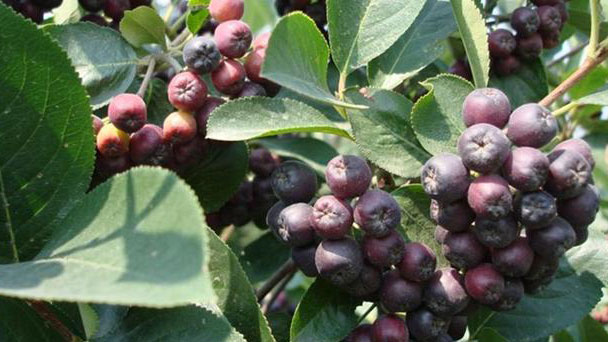
Black Chokeberry (Aronia melanocarpa) is an excellent landscape shrub with multi-season interest. Dark, glossy leaves of Black Chokeberry turn purple, orange and bright red in the fall. The Black Chokeberries should be harvested in late August or early September and can be used as juice, dried, braised or simply frozen to make smoothies. Black Chokeberry is about 5-7 feet tall and about 5 feet wide.
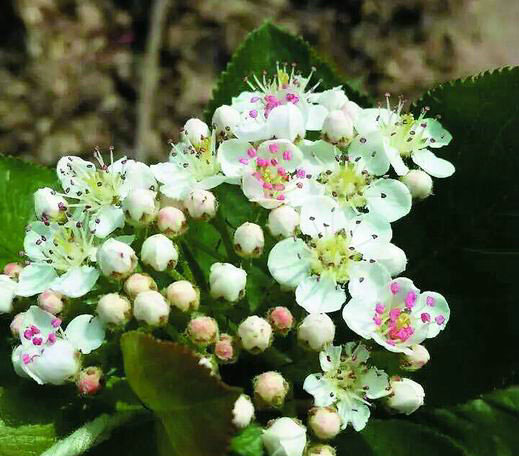
Black chokeberry flowers have five white petals and numerous pink stamens. As many as 30 flowers occur in each 2-inch diameter cluster. They open in mid-May, late enough that they are not often affected by late spring frosts. Primary pollinators are small bees.
Black chokeberry fruits are 1/3 – 1/2 inch diameter, glossy and black when ripe. They hang down in clusters from red pedicels, with few-to-30 fruits per cluster. The fruits are pomes (like apples), and each contains 1-5 seeds. They mature primarily in August. Shortly after maturation, the fruits shrivel and most drop.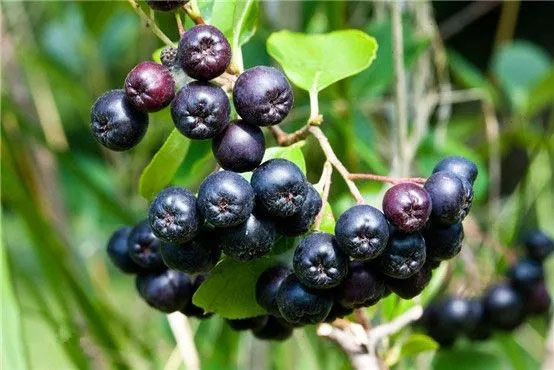
Although Aronia melanocarpa is native to eastern North America, it is widely planted in eastern Asia. In 1967, Howard Brooks, of the United States Department of Agriculture, collected plants in Russia to test at an Iowa site. The plants there suckered freely — a trait that may be desirable, depending on the location. Although studies note that chlorosis may be a problem in alkaline soils, no symptoms were detected on any of the specimens here at the Chicago Botanic Garden, where soil pH can reach 8.5.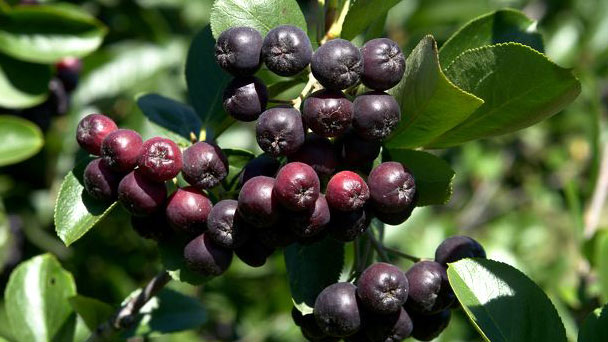
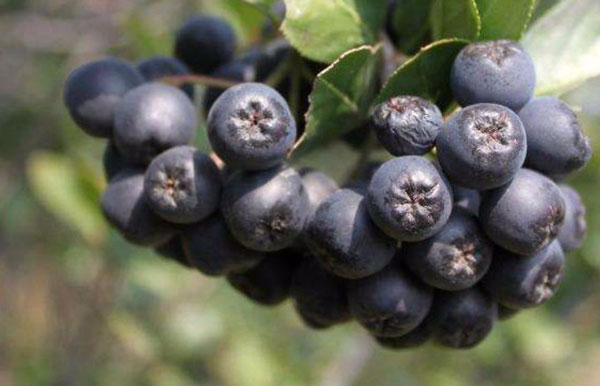
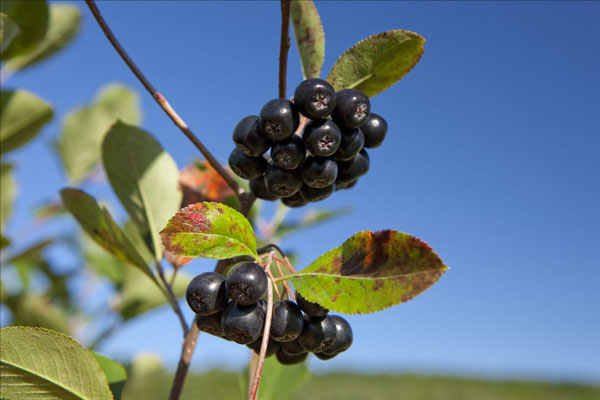
In recent history, black chokeberry has been extensively produced in Russia as a small fruit, used in juice products (mixed with apple juice), wine, compote, and pickles (Kask). It has been commercially grown in Europe where its fruits are used in juice, alcoholic beverages, energizing beverages, and as a food colorant (Bussieres et al.). Sweden initiated studies to develop this crop in 1986 (Jeppsson and Johansson). Knudson notes that fruits can be canned whole, the juice can be used in fruit drinks and jelly, and extracts can be used as natural colorants in the food industry.
The fruit of black chokeberry has higher levels of antioxidants (anthocyanins and flavonoids) than any other temperate fruit. This is generating an increasing level of interest among small fruit producers in the U.S.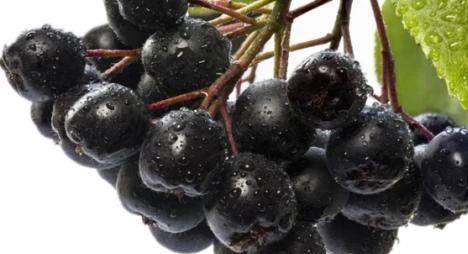
Black Chokeberry ‘Autumn Magic’: This shrub has a more compact growth habit than the main species plant but with large clusters of fruit.
Black Chokeberry‘Iroquois Beauty’: This variety also has a compact growth habit and features particularly vivid fall color.
Black Chokeberry‘Viking’: This variety is known for its large black fruit and also sports vivid fall color.
Black Chokeberry‘McKenzie’: This is a tall variety that can grow up to 12 feet.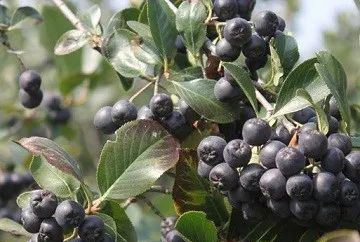
Include a dwarf form in an edible raised bed kitchen garden.
Plant a larger variety in a row to screen a property line.
Place along a stream or other naturally wet area where plants can spread naturally.
Create an edible garden area along a slope using chokeberry and blueberry shrubs, with groundcover strawberries as an underplanting.
Use a medium-sized variety as a foundation planting. Combine with other shrubs with multi-seasonal interest for an ongoing color display.
Use a groundcover variety instead of a grass lawn in a challenging area that gets plenty of sun.
Plant a hedge of a medium-sized variety to divide garden rooms and keep the hedge sheared for a formal look.
Use a medium to large variety as a stand-alone focal point in an island bed.
Plant alongside other native plants to create shelter and food for birds and other wildlife.
Black Chokeberry PictureBlack Chokeberry InfoEcological Habits of Black ChokeberryBlack Chokeberry DistributionHow to Grow and Care for Black Chokeberry How to Grow Black ChokeberryHow to Care for Black ChokeberryUses of Black ChokeberryNutraceutical UsesLandscape UsesWildlife UsesVarieties of Black ChokeberryBlack Chokeberry Common Pests/DiseasesBlack Chokeberry Design TipsBlack Chokeberry Companion Plants
Black Chokeberry Picture

Black Chokeberry Info
| Botanical Name | Aronia melanocarpa |
| Common Names | Black chokeberry, aronia berry, aronia, chokeberry |
| Plant Type | Shrub |
| Mature Size | 3–6 ft. tall and wide |
| Sun Exposure | Full, partial |
| Soil Type | Well-drained |
| Soil pH | Acidic |
| Bloom Time | Spring |
Ecological Habits of Black Chokeberry
Black chokeberry is a multi-stemmed, deciduous, eastern North American shrub. It reaches 4–8 feet in height, but in cultivation, and with a selection of hybrids, many plants available in commerce reach only the lower end of this height range. The plant’s habit is multi-stemmed, and plants can form large, dense colonies over time.Black chokeberry flowers have five white petals and numerous pink stamens. As many as 30 flowers occur in each 2-inch diameter cluster. They open in mid-May, late enough that they are not often affected by late spring frosts. Primary pollinators are small bees.
Black chokeberry fruits are 1/3 – 1/2 inch diameter, glossy and black when ripe. They hang down in clusters from red pedicels, with few-to-30 fruits per cluster. The fruits are pomes (like apples), and each contains 1-5 seeds. They mature primarily in August. Shortly after maturation, the fruits shrivel and most drop.

Black Chokeberry Distribution
A member of the rose family, Black Chokeberry tolerates partial shade (up to 50 percent) but thrives in full sun. Hardy to zone 3 (the Chicago area is zone 5), it is also an excellent choice for those tough, low-lying wet areas where only moss and mosquitoes flourish. And yet it can acclimate itself to dry, sandy locations as well.Although Aronia melanocarpa is native to eastern North America, it is widely planted in eastern Asia. In 1967, Howard Brooks, of the United States Department of Agriculture, collected plants in Russia to test at an Iowa site. The plants there suckered freely — a trait that may be desirable, depending on the location. Although studies note that chlorosis may be a problem in alkaline soils, no symptoms were detected on any of the specimens here at the Chicago Botanic Garden, where soil pH can reach 8.5.

How to Grow and Care for Black Chokeberry
How to Grow Black Chokeberry
- With Seeds
- With Cuttings

How to Care for Black Chokeberry
- Light
- Soil
- Water
- Temperature and Humidity
- Fertilizer
- Pruning

Uses of Black Chokeberry
Nutraceutical Uses
Black chokeberry fruits are unpleasant when raw (hence the common name), but when processed they have culinary and nutraceutical value. Smith notes that, historically, the Potawatomi people used the fruits as food and made an infusion of fruits as a treatment for colds. The Abnaki also used fruits as a food (Rousseau).In recent history, black chokeberry has been extensively produced in Russia as a small fruit, used in juice products (mixed with apple juice), wine, compote, and pickles (Kask). It has been commercially grown in Europe where its fruits are used in juice, alcoholic beverages, energizing beverages, and as a food colorant (Bussieres et al.). Sweden initiated studies to develop this crop in 1986 (Jeppsson and Johansson). Knudson notes that fruits can be canned whole, the juice can be used in fruit drinks and jelly, and extracts can be used as natural colorants in the food industry.
The fruit of black chokeberry has higher levels of antioxidants (anthocyanins and flavonoids) than any other temperate fruit. This is generating an increasing level of interest among small fruit producers in the U.S.
Landscape Uses
Black Chokeberry notes that black chokeberry was introduced to western gardens as a landscape plant around 1700 and that its value is reflected by its receipt of the Royal Horticultural Society's Award of Merit in 1972. Its ornamental attributes include three seasons of interest: white flowers in spring, lustrous green foliage in summer and black fruits in late summer, and bright yellow-orange-red foliage in autumn. There is growing interest in this plant as a multi-season native shrub for landscapes in the eastern U.S. It is easy to propagate and produce in nurseries. Its adaptability to a wide range of soil conditions and freedom from major problems makes it a good candidate for wetland reclamation projects, roadside and highway plantings, and parking lots.Wildlife Uses
In wildlife habitats and in wildlife gardens, black chokeberry provides browse for white-tailed deer and rabbits, and fruits for ruffed grouse, sharp-tailed grouse, and prairie chickens (USDA, NRCS).
Varieties of Black Chokeberry
There are several varieties of black chokeberry that vary slightly in appearance, including:Black Chokeberry ‘Autumn Magic’: This shrub has a more compact growth habit than the main species plant but with large clusters of fruit.
Black Chokeberry‘Iroquois Beauty’: This variety also has a compact growth habit and features particularly vivid fall color.
Black Chokeberry‘Viking’: This variety is known for its large black fruit and also sports vivid fall color.
Black Chokeberry‘McKenzie’: This is a tall variety that can grow up to 12 feet.
Black Chokeberry Common Pests/Diseases
Aronia berry bushes are not prone to disease or to pests. They will rarely develop leaf spot or rust. Both of these are fungal type infections and are cosmetic in nature. They can be avoided if you water your aronia berry bush at the ground level rather than drenching the foliage with water. Plenty of elbow room will allow good airflow around the leaves, too, which will help prevent disease or damage.
Black Chokeberry Design Tips
With all the variation and seasonal interest that aronias bring to the garden, the uses are nearly endless.Include a dwarf form in an edible raised bed kitchen garden.
Plant a larger variety in a row to screen a property line.
Place along a stream or other naturally wet area where plants can spread naturally.
Create an edible garden area along a slope using chokeberry and blueberry shrubs, with groundcover strawberries as an underplanting.
Use a medium-sized variety as a foundation planting. Combine with other shrubs with multi-seasonal interest for an ongoing color display.
Use a groundcover variety instead of a grass lawn in a challenging area that gets plenty of sun.
Plant a hedge of a medium-sized variety to divide garden rooms and keep the hedge sheared for a formal look.
Use a medium to large variety as a stand-alone focal point in an island bed.
Plant alongside other native plants to create shelter and food for birds and other wildlife.
Black Chokeberry Companion Plants
Consider combining Glossy Black Chokeberry with other native shrubs such as Grey Dogwood, American Filbert, or Common Witchhazel to create a mixed screen. Add smaller shrubs such as Common Snowberry, New Jersey Tea, or Meadowsweet along the front of the border for a layered effect and even more wildlife appeal. Add in some red milkweed to attract Monarch butterflies and other pollinators.Latest Updated
- Benefits of Bugleweed - 7 Science-backed Health Benefits
- Bugleweed Dangers & Side Effects - Is It Poisonous?
- How to Plant Evergreen Trees - What You Should Know
- When to Plant Evergreens - Grow Guide for Evergreen Trees
- 12 Wonderful Evergreen Shrubs for Your Garden
- 12 Popular Evergreen Plants with Pictures for Beginners
- When And How To Prune A Lilac Bush Like a Pro
- How to Grow & Care for Lilac Vine (Hardenbergia Violacea)
- Japanese Lilac Tree (Syringa Reticulata) Care & Propagation Guide
- Shumard Oak Pros and Cons - What to Know
Popular Articles
- Winter maintenance of Antirrhinum Majus
- How to Grow Terminalia Mantaly Tree
- How to Grow and Care for Crossostephium Chinense
- How to grow Antirrhinum Majus in spring
- Peristeria Elata (Dove Orchid) Profile: Info & Care Guide
- Underwatered Snake Plant (Sansevieria Trifasciata) - Signs And How To Fix
- How to Care for Brazilian Jasmine Plant (Mandevilla Sanderi)
- How to Grow & Care for Graptopetalum Purple Delight in Summer
- Rosa Chinensis (China Rose): Plant Growing & Care Tips
- How to Care for Baby Sun Rose (Aptenia Cordifolia)